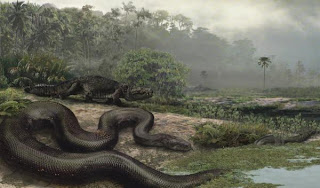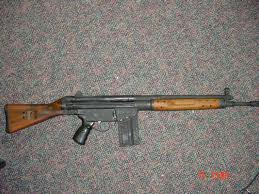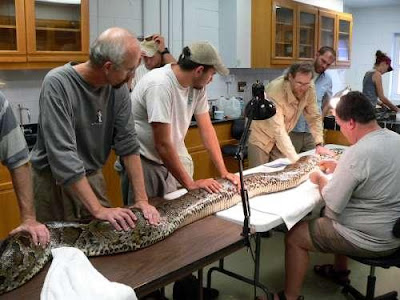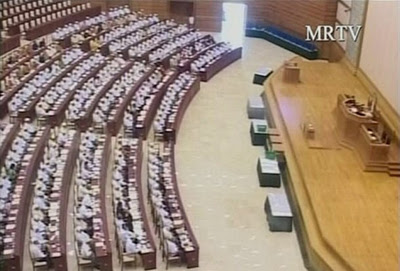 |
| Ancient Giant Snake (Jason Bourque/msnbc) |
We backtracked our way along now familiar trails the whole night and reached a seemingly safe spot in the early morning and decided to take a meal rest. The place was a narrow grassy clearing between a high cliff and a wide but shallow creek. Many big logs together with a few big tree trunks fallen from the cliff top with their roots still intact scattered on the ground.
The shallow and clear creek was steadily flowing from the nearby pond at the base of the curved cliff. Loudly dropping from the top of the high cliff the wide waterfall cascaded into the shallow rock pond surrounded by a dense forest of palm trees and wild banana plants and tree ferns.
As we were all sick and tired of the dried-meals we had been eating for the last five days Soe Win made a small fire of dried twigs and started cooking rice in two of our metal hangaws which were basically the personal rice cooker-cum-kettle for a Burmese soldier. The standard use of hangaw was one of many traditions handed down by the Japanese Army during the last big war. Our hangaw was the exact copy of Japanese Han-gou mess kit.
 |
| Burmese Army's Hangaw Mess-kit. |
Basically it was a 6 inches high, 4 inches wide, and about 3 inches thick kidney-shaped, brown-painted, oval-bottom, heavy-gauge aluminium rice-cooker pot with lid and a tray. The tray is about 2 inches deep and same shape as the pot and lid and stored inside the pot. Inside the pot are two lines marked rice and water.
Fill the rice up to the rice line and then add water to the water line and put the lid back on and hung it above the fire by its swinging handle. Within ten minutes the rice is cooked and ready to be consumed, as simple as that. The outside-back of our army-issued flimsy backpacks had the strap -hangings to firmly tie down a hangaw.
Naw Taung also went to a great trouble boiling a nice smelling stew with a cup of split-pea and a few pieces of dried game jerky we brought along. He also picked a hand full of green chilli and some new leaves from the wild chilli bushes nearby and added into his boiling stew with a broad grin on his face.
The aroma of fresh green chili from the stew boiling inside the hangaw on the fire reached inside my nostrils and it almost watered my mouth. I was so hungry now that I could even hear the grumbles from my overly empty stomach. Being hungry most of the time was the well established part of our soldering life in this jungle, I bitterly thought.
Log or a Snake
Smell delicious. I am very hungry now. Hurry up, Naw Taung, rice’s cooked already, extremely hungry Soe Win yelled out to Naw Taung who was busily stirring his stew in the hangaw hanging just above the fire. He then carefully lifted the hot rice hangaws from the fire by its handles with a long bamboo stick and nicely put it on a big brownish log nearby, part of which was obscured under the thick undergrowth.
Then to my surprise and Soe Win’s too, the big log moved with a sudden jerk under our tired eyes and the rice hangaws on it were violently thrown off and fell on the ground not far from where I was carelessly sitting cross-legged with the G4 on my lap. I was supposed to be the standing sentry while they were cooking. But I was too hungry to worry anymore about enemy as my mind now was rather on filling my empty stomach.
What the hell? That fucking log just moved, ..…….., it’s still moving! Soe Win was by then seriously alarmed. Jesus Christ, that is not a log. It’s a fucking snake. A big fucking python! Yelled Naw Taung aloud as he had just turned round from his stew over the fire towards where Soe Win was and saw what was slowly unfolding right under our eyes. He immediately ran to his backpack on the ground and grabbed the stubby Kachin sword tied on it and drew the blade from its scabbard. He then rushed back to the slowly moving log-like snake.
 |
| Kachin Sword. |
Kill it, kill it, before it gets away from us, shouting, I jumped up with rifle in my hands and cocked the gun and aimed at the now slowly moving yellowish-brown body of the biggest python I had ever seen. Much, much bigger than the huge one I used to go see so many times in the Zoo back in Rangoon.
Don’t shoot the body. Aim the head, Naw Taung yelled at me while quickly striding alongside the big snake’s slithering body as if he was trying to locate the snake’s head. What’s the difference between the head and body? Don’t you want me to kill the bloody thing? I yelled back at him with a slight confusion at the same time holding my fire.
There’s something in its stomach. Must be a big one, probably a boar? That’s why it can’t move well. Just shoot the head. Listen to me. I want its gall bladder and the skin too. Undamaged and dried, it will fetch good money from the Chinese in town, Naw Taung, who was quite familiar with the wild life trade in the town, yelled back at me with an obvious excitement. But where is the fucking head? I had to ask him as I still couldn’t locate the head yet let alone take a shot at it.
Giant Python
Meanwhile, Naw Taung had hacked off the small bushes ahead of him and he stumbled onto something slippery in the undergrowth and suddenly jumped out of its way. Instead of slithering away from us the big snake had just turned its head towards Naw Taung and now slowly coming out of the tall grass.
I soon realized that the giant snake was more than thirty or even close to forty foot long as its thick pointy tail, now slowly disappearing into the thick undergrowth, was still almost at the water edge. Its huge head started coming out of the grass tunnel it had made as a tight shelter in the dense undergrowth for the long digestion, conveniently under the sun, of whatever big prey it had in its enormous stomach.
When I clearly saw it the giant snake was slowly lifting its head and upper body into the air right in front of Naw Taung who was now standing seemingly or strangely hapless almost within the arm length from the snakehead. I was now about ten feet away from the heavy diamond shaped snakehead as the big snake was raising its huge head up heavily to first our waist height and then slowly to our eye level.
Its snout was initially pointing upward and I could see the yellow belly under its huge head, which was much wider than its neck. Slowly the head levelled and its orangy eyes appeared to stare right into Naw Taung’s now bulging eyes.
I first thought his attention was fixed on the snakehead but then in my horror I realized that he was now under some kind of strange spell. He just stood there dangerously so close just a couple of feet away from its swaying head and slow darting tongue, like he was being hypnotized into a trance like state.
The elongated-diamond-shaped head with flat top had two yellowish lines on its sides running horizontally across each eye. The orange eyes with no eyelids were enormous and the slits like vertical pupils were mesmerizing in a strange way. At that moment I forgot about my original idea of shooting and killing it. I just felt like I wanted to see its swaying head and darting tongue forever.
 |
| BA63 or G3 Rifle. |
Shoot, Hla Oo, shoot. It’s gonna strike him. Shoot! I heard the high pitch tone of Soe Win’s loud voice from behind. Hla Oo, what’re you waiting for? Shoot it now! Shoot! he just kept on yelling at me as if I’d turned suddenly deaf.
I turned my head and saw him, shaking and trembling with terrible fear, standing knee deep in the shallow water of the creek. It appeared that snake-scared Soe Win tried to run away and ended in the pond. He was now shouting at me at the top of his voice to shoot the snake. His panicky loud voice definitely had jolted me out of the trance I was in without being really aware of its strange hold on me.
I stepped back a few steps to get a clear shot at its head. I aimed my G4 carefully at its head and fired two rounds in succession. Dang, dang, with its drumbeat like noises the highly explosive bullets blew the head away and the headless mass of upper body violently shook sideways in the air a few times and then heavily fell on the ground like a cut-down tree trunk and shook the soft ground I was standing on.
 |
| BA64 or G4 Light Machine Gun. |
The tail and rest of the long body twitched and shook like the cut off tail of a sun lizard but in a much much greater scale with the accompanying noisy trampling on the saplings and tall grass around. The mighty shake went on for a while as if the headless body in the undergrowth had still wanted to slither away from us.
Eventually the life slowly vanished from every inch of its huge body and the dead snake stayed still like a log it seemed to us at the beginning. The whole length of the snake had been now out in the open as its death struggle cleared away all the grass and part of undergrowth covering its long body before.
Out of the creek, young Soe Win rushed past me to Naw Taung, who was partly showered with flesh and blood from the exploded snakehead, and forcefully shook him back to life, Wake-up, Naw Taung, It’s dead. Wake-up!
What happened? Did the snake hypnotize you? I tried to figure out what exactly happened to him. You were in a bloody trance! I asked him again as he was still standing there with a blank expression on his wide-eyed face. I don’t know. I just couldn’t move. I didn’t fall asleep. Strange though, I felt like I was completely paralysed, he replied me in a trembling voice as a result from the close encounter with the enormous Burmese python, probably the largest snake on the planet, I reckoned.
My father often told me about these big pythons and what happened to one of his cousins a long time ago when they were young and growing up in this area, he continued talking in his still shaky voice. What happened to your uncle? Was he taken alive? Young Soe Win was very interested in his story.
Almost. A huge python put him in a trance, then grabbed him by the neck and started constricting him tightly in its coils. Father and his brother saw it. So they cut the python and let him free. But it was too late and he died later. His ribs were broken and blood vessels exploded inside the body. He said it was a very slow and painful dead, he then paused, took a deep breath, turned towards me, and said, Thanks, Hla Oo. You’ve saved my life!
Not me. It was Soe Win. I was also in a trance like you and couldn’t even move. Soe Win yelled at me and his voice kicked me out of it. That was a close call. We could all have been killed, I replied him casually at the same time released the magazine and cleared the single bullet from the chamber by cocking the gun. For safety reason I didn’t want the gun in the loaded condition since the immediate danger was over.
I picked up the ejected bullet from the ground and thumbed it back into the magazine and stuck the magazine back into the gun. Naw Taung walked back to the middle of the long dead body and started feeling the bulging stomach and said, Now I have to cut open the body and get the gall bladder.
The girth of the stomach was so big I didn’t think I could encircle it with my two hands together. The diameter of the body at its widest might have been more than two ft or even 3 ft. It could be one of those giant river snakes the natives talked about in great fear. It was far too big to hide easily, even in this thick jungle, and the deep waterways might be their home and hunting ground.
Our giant snake might have grabbed and swallowed a big prey on the water-edge at a deeper part of the creek and slowly swam upstream and then nicely taken shelter in thick undergrowth under sun light to digest the prey in its stomach. But its luck ran out when young Soe Win mistook it as a big brown log to rest his hot hangaws on.
Cut the Snake Open
Instead of wildly opening the body Naw Taung was now looking for the right spot of the valued gall bladder. He then asked me, Do you know the medicinal value of a dried gall bladder? Chinese herbalists pay good money for one from a python, as he thought a boy like me from the big city didn’t know that sort of stuff. He was completely wrong.
Yeah. My grandma used it to treat any bad things to do with our eyes. She kept a small piece of it in her medicine bag and took it along wherever she went. I still remember when I was in year four; I got punched on the eye in a fight with a group of Muslim boys. It was so bad I couldn’t see through my left eye, I recalled.
She made me lie down face up in bed, grounded a tiny piece of dried gall bladder, mixed it with cold water, and dropped the liquid slowly into my eye, I said. It was so bitter I could feel the sharp bitterness at the back of my tongue once it went inside me eye. But it relieved the pain immediately and few hours later my eye was back to normal. Naw Taung definitely was surprised at hearing my own python gall-bladder story.
It could also cure stomach pains. But it’s the best for the eye sores, he enthusiastically agreed with my experience. So where is it in the snake’s body? I mean that bladder thingy! asked Soe Win who was now bravely feeling the large smooth scales on the dead snake’s cold skin.
Normally it is between the stomach and the small intestine not far from the liver. Ok, I think I’ve found the right spot, he then started to turn the belly towards him without success as the huge body was too heavy for him. We both helped him and managed to partly expose the yellow belly of the big snake. He then cut a foot long slit with his sword and the slimy and smelly stuff from the inside fell out onto the ground once he pried the slippery body wide open with the blade.
 |
| Snake's Anatomy (Merriam-Webster) |
There it is. That greenish pear-shaped one still attached to the intestine, he carefully picked up the small watermelon-sized piece of dark-green offal and cut it free from the rest of the mess. He then wrapped it with the banana leaves, which were cut off by Soe Win earlier from the wild banana plants nearby, and put the whole package into his knapsack.
He then moved back closer to the body and started cutting the exposed stomach which was still intact inside the body. The rotten smell of the slimy liquid seeping out from inside instantly repelled me and the adrenalin driven excitement had suddenly gone out of me.
 |
| Kachin Sword |
We should be moving on. Wasting time here on a bloody snake. I don’t like it at all, at that moment I began to worry about the trip back to base. I also had to keep reminding myself that I am no longer a boy to be playing together with them as sometimes I forgot I was the squad leader responsible for two of them too.
Don’t you want to see what’s inside the stomach? Naw Taung still wanted to hang on to his huge catch. No, forget about it. That fucking smell is killing me, right now. Let’s move! I was determined to start moving. How about our meal? Soe Win remembered the meal we were preparing just before. But I didn’t think we were hungry anymore as the fear and excitement had taken away all our hunger.
No, I don’t feel like eating at all. We will eat at the base. Just chew the jerky on the way, I insisted and they both had to give in. We killed the fire and picked up our stuff from the now very messy ground and started walking back to where the main trail was.
A lot of meat on that snake. Bloody pigs will have a big meal soon! Naw Taung murmured to himself on the way walking behind me. Pigs eat snake? Soe Win at the point heard him, turned round and asked without stopping on the track.
Yeah. Wild pigs eat almost everything in this jungle. They eat human flesh too. Long, long time ago well before we’d become Christians, our ancestors didn’t bury corpses. They left the dead in a shallow hole and wild pigs would take care of the rest. They used to say Kachin eat pigs and pigs eat Kachin, a natural way of recycling. Missionaries stopped that practice. Funny … isn’t it? On the way Naw Taung was becoming quite talkative and I had to shut him up since I didn’t want any one to hear us from the distance. Even in a thick jungle sound travels far.
It took us just over a day only to reach the base as we already knew the trails well. Our sergeant-majors were very pleased with the documents and the gun we brought back. And the old Kachin CO of our Company promised to make me a lance-corporal soon.
The story of our encounter with the enormously huge python also spread like wild fire first inside the base, thanks to Soe Win, and later even into the large Kachin village down in the valley by Naw Taung who frequented there whenever he was allowed.
Sad Epilogue
With Naw Taung’s precise directions to the site some villagers from Htawgaw went there few days later and peeled the whole skin of the partly-pig-eaten snake and sold it to the Chinese traders at Chibwe for a good sum of kyats.
The news of the giant python even traveled back to Myitkyina as the long roll of extremely wide snake skin re-appeared at the bustling wildlife market in town followed by the unbelievably exaggerated story of its slaying by a squad of Burmese soldiers in a jungle by the faraway Chinese Border.
 |
| M1 .30 US Carbine. |
I didn’t really know how much money Naw Taung made out of the sale of the skin but I was so sure he had spent it all on Duya cigarettes as he was a chain smoker. A month later he killed one Burmese sergeant from our Company during a hunting trip, took his carbine, and joined our nemesis KIA Battalion 202, the Second Battalion of KIA Second Brigade, which controlled the North Eastern Kachin State.
As a young Kachin he was really a KIA sympathizer from the beginning and hence they made him an officer in that battalion as the reward. With his inside knowledge of our bases on the Htawgaw Hills KIA staged a daytime daring raid on us a couple of weeks after his defection.
By using one of our secret tunnels the KIA raiding party guided by our own Naw Taung avoided the minefields and appeared inside the wire and surprised us in our own trenches. I was stabbed in the belly but I managed to finish my young attacker off as I wrote before in The Scourge of Burma – Part 2. But Soe Win was unlucky as he was shot four five times in the chest and died later in my arms.
Before he died he wept and sobbed and told me he wanted to go home to see his mother. The young boy never talked about his mother before. He was just 14 or 15 and he’d been in army for more than a year by then. I was so sad I promised him that I would take him home. Of course I was lying just to comfort him, but he was pleased and left us forever with a faint smile on his face when he died.
That afternoon we found Naw Taung’s body with multiple gunshot wounds by the tunnel exit just after the wire. Apparently he was fatally wounded in the trenches and died later while trying to escape after their surprise raid had failed miserably. All 15 of them Kachins from the raiding party were killed and we lost 22 Burmese and one Kachin soldier on our side if I still remember correctly.
Later the older men from our Company started telling me that the whole thing was because of the curse from us killing the giant python and I would soon be punished too as both Soe Win and Naw Taung were dead now. I was scared shitless I refused to go out of the base for more than a month as even the normally tight-arse Sergeant-Majors let me avoid the regular patrol duties beyond the wire.
(Lone Messenger and Digesting Python chapters from my book Song for Irrawaddy were based on this encounter.)



























